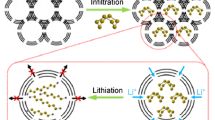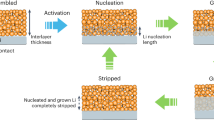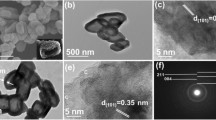Abstract
We report on synthesis and electrochemical properties of a family of carbon-coated, mesoporous lithium titanate nanostructures (C@Li4Ti5O12). Synthesized using a scalable solvothermal approach employing low-cost petroleum pitch as the carbon source, the nanostructured C@Li4Ti5O12 materials manifest exceptional capacity to reversibly intercalate/de-intercalate lithium at both low and high charge rates. The combination of fast electrolyte and ion transport made possible in the inherently zero-strain material, Li4Ti5O12, is thought to be responsible for our observations.
Similar content being viewed by others
Introduction
Among the various existing battery technologies, lithium ion batteries (LIBs) have found widespread use in today’s electronics and telecommunications sectors. There are three generally accepted reasons for the growing acceptance of LIBs: their high energy density, longer shelf life relative to other secondary battery technologies and broad operating temperature range. In addition, LIBs are space friendly and are widely viewed as the ultimate choice for HEV and PHEV applications (Armand and Tarascon 2008). Despite the remarkable growth and widespread acceptance of LIB technology, the exploitation of LIBs for high power applications has been limited by issues related to safety, capacity fade over many charge/discharge cycles, and slow kinetics of lithium insertion/de-insertion processes in the electrode materials. Accordingly, demand for novel electrode materials capable of rapidly and reversibly intercalating lithium has grown considerably.
In general, capacity fade in LIBs can be attributed to the variation in lattice dimensions of the electrode material as it undergoes repeated charge–discharge reactions (Ohzuku et al. 1995). Materials undergoing electrochemical topotactic transformation associated with the insertion or extraction of Li+ ions are consequently preferred for potential lithium battery applications (Ohzuku et al. 1995). The cubic spinel Li4Ti5O12 is one such material which manifests almost zero strain and negligible changes in its crystal lattice structure upon repeated lithium insertion and extraction (Cheng et al. 2010; Park et al. 2008; Prakash et al. 2010). Li4Ti5O12, is capable of accommodating three Li+ ions per formula unit at ~1.5 V during charging, and has a theoretical capacity of 175 mAh/g (Ohzuku et al. 1995; Cheng et al. 2010; Park et al. 2008). Though almost half the theoretical capacity of currently used LiC6 (360 mAh/g), and notwithstanding its high intercalation voltage (Wang et al. 2009; Colbow et al. 1989; Amatucci et al. 2001), Li4Ti5O12 is attracting considerable attention as the candidate of choice for the LIB anode in high power applications because of its safety and structural stability (Amine et al. 1997, 1998, 2002). In addition, it has been shown that when Li4Ti5O12 is coupled with high voltage cathode materials such as LiMn2O4 (Pasquier et al. 2009) and LiNi0.5Mn1.5O4 (Wu et al. 2009), the latter limitation is remedied.
Herein we report the synthesis of carbon-coated Li4Ti5O12 via an in situ carbonization scheme, employing low-cost petroleum-based pitch as the carbon source. We show that the product of this synthesis, C@Li4Ti5O12, exhibits markedly improved capacity retention, particularly at high rates, when compared to pristine Li4Ti5O12.
Experimental
Mesoporous TiO2 with high surface area was synthesized using a modified urea-assisted hydrothermal method at 95°C, as reported previously (Guo et al. 2003; Jung et al. 2009). In a typical synthesis, urea (1 M) and ammonium sulfate (0.01 M) were added to a solution of TiCl4 (0.6 M) in a 1:1 water–ethanol mixture. The contents were transferred to a Teflon-lined autoclave and heated at 95°C for 5 h. The resultant TiO2 particles were washed, dried and suspended in N-methyl-2-pyrrolidone solvent. The suspension was heated at 125°C with stirring until the solvent began to evaporate. A calculated amount of pitch was added to the suspension along with a stoichiometric quantity of lithium carbonate. The suspension was subsequently stirred until complete evaporation of the solvent, and the resultant brown-colored precursor calcined under an Argon atmosphere at 900°C for 20 h. Pristine Li4Ti5O12 without carbon coating was synthesized using a similar procedure.
Characterization of the samples
Transmission electron microscopy (TEM, Tecnai, T12, 120 kV), powder X-ray diffraction (Scintag X-ray diffractometer with Cu Kα radiation), thermo gravimetric analysis (under air, Thermo Scientific TA Instrument (Nicolet iS10) operated at a heating rate of 20°C min−1), nitrogen adsorption/desorption measurements (Micromeritics ASAP 2020 instrument after degassing the samples at 200°C for 4 h), electrochemical charge discharge analysis (Maccor cycle life tester, under the potential window 3.0–0.5 V).
Electrochemical characterization
The pristine and C@Li4Ti5O12 anode slurry was made by mixing 87.5% of the synthesized C@Li4Ti5O12 (85% of pristine), 5% super-p carbon (7.5% for pristine) and 7.5% of PVDF binder in NMP dispersant. Negative electrodes were produced by coating the slurry on copper foil and dried at 120°C for 1 h initially and at 100°C for 4 h in vacuum oven. The resulting slurry-coated copper foil was roll-pressed and the electrode was reduced to the required dimensions with a punching machine. Preliminary cell tests were conducted on 2032 coin-type cells, which were fabricated in an argon-filled glove box using lithium metal as the counter electrode and a micro porous polyethylene separator. The electrolyte solution was 1 M LiPF6 in 1:1 EC:DEC.
Results and discussion
The schematic representation of the synthesis procedure is shown in Fig. 1a. The conductivity of the pristine Li4Ti5O12 is very low (10−13 S/cm) owing to the existence of Ti in its tetravalent state, which limits its utilization in high-rate LIBs applications (Chen et al. 2001). Accordingly, carbon coating has been pursued as a strategy to alleviate the conductivity-related issues. Hence, in the current synthesis procedure, nanostructured mesoporous TiO2 spheres with a surface area of 116.49 m2/g were soaked with pitch, as a carbon precursor, and lithium carbonate in NMP solvent. As each TiO2 sphere is assembled from a huge number of fine primary nanoparticles (10–20 nm) with high porosity, the pitch dissolved in NMP can easily creep into the TiO2 spheres thereby ensuring complete coating of the primary particles.
Figure 1b shows the XRD patterns of typical materials synthesized using the above procedure at each step of the synthesis. The starting precursor is indexed to anatase TiO2 with a tetragonal lattice structure (JCPDS card no. 21-1272). The nanosized pristine and carbon-coated Li4Ti5O12 patterns can be assigned to the cubic spinel lattice structure (JCPDS file no. 49-0207). It is noteworthy that the XRD pattern of the C@Li4Ti5O12 material is silent in the scattering vector range associated with carbon. This finding implies that the carbon is presented in disordered/amorphous form in the coating (Jayaprakash 2007). The mean crystallite size calculated from the (111) peak using Scherrer’s formula is found to be about 25 nm for the C@Li4Ti5O12, 52 nm for the pristine Li4Ti5O12 and 15 nm for the TiO2 precursor [from (101) peak]. It is noticeable from the calculated crystallite size values that there is a considerable increase in the average value after calcination at 900°C. The influence of high temperature calcination on crystallite size is noticeably less for the C@Li4Ti5O12 particles, presumably reflecting the presence of a thin buffering layer of carbon. The amount of carbon present in the C@Li4Ti5O12 sample has been determined by thermo gravimetric analysis to be ~20 % (shown as inset in Fig. 4d).
The pore size distributions calculated by the Barrett–Joyner–Halenda method (Fig. 2a–d) for all materials studied confirm the presence of well-developed mesoporosity with very narrow pore-size distribution centered at 4, 6.5 and 4.7 nm for TiO2, pristine Li4Ti5O12 and C@Li4Ti5O12 materials, respectively. The BET surface area values calculated are 29.9 and 49.7 m2/g for pristine Li4Ti5O12 and C@Li4Ti5O12, respectively. As expected, the high temperature calcination step has reduced the surface area and porosity of both materials, considerably. This observation is in accordance with the average crystallite sizes calculated from the above XRD analysis.
The morphology of the synthesized materials was further examined by TEM measurements (Fig. 3a–d). It can be seen that the spheres are relatively uniform with diameters in the range of 300–500 nm. Furthermore, it is interesting to note the manner in which carbon has been coated to the Li4Ti5O12 particles; it is apparent that carbon has been coated to the spherical core Li4Ti5O12 particles uniformly, typically by generating a void space separating the core and the carbon coating (Fig. 3c). However, upon magnifying the TEM image to a higher resolution (Fig. 3d), it can be seen that the space in between is not completely void, but rather is packed with an ultra-thin filmy layer of amorphous carbon connecting the core and the outer carbon coating. It is expected that such a filmy layer of carbon will facilitate easy diffusion of Li+ ions into the core Li4Ti5O12 particle, in contrast to a bulky carbon deposit, during the electrochemical charge–discharge processes. Figure 3d represents an EDAX spectrum from the outer filmy layer, which confirms the existence of carbon alone as a spongy deposit on the particle exterior.
The electrochemical charge–discharge behavior of the nanostructured pristine and C@Li4Ti5O12 materials was investigated using coin-type cells (2,032) comprised of the synthesized materials as the working electrode against lithium metal counter electrode. The cells were discharged and charged at a 0.1C-rate for the first ten cycles and at a predetermined higher C-rate for the subsequent cycles under the voltage window of 3.0–1.0 V. The typical voltage versus capacity plots for the nanostructured pristine Li4Ti5O12 and C@Li4Ti5O12 materials are compared in Fig. 4a–c, wherein very flat Li+ ion insertion and deinsertion plateaus around 1.54 and 1.57 V respectively are observed. Interestingly, despite its significant content of inactive carbon, the nanostructured C@Li4Ti5O12 material delivers a higher initial discharge capacity of 166 mAh/g than pristine Li4Ti5O12 (148 mAh/g) even at the relatively low rate of 0.1C. We suspect that this behavior stems from the smaller crystallite size and higher surface area of the nanostructured C@Li4Ti5O12 active material in the anode. More significantly, after 120 cycles at a 1C-rate, the C@Li4Ti5O12 material manifests a remarkably reversible capacity of 156 mAh/g, compared to only 76 mAh/g for pristine Li4Ti5O12; underscoring the profound benefit of the carbon coating.
Figure 4c and d show the rate capability behavior of our pristine and C@Li4Ti5O12 materials, wherein the cells were charge and discharged at the same C-rates, up to maximum of 7C, set by the current input restriction on the measurement device used for the charge–discharge cycling. As expected, the C@Li4Ti5O12 exhibits superior rate capability behavior compared to the pristine Li4Ti5O12. Specifically, the nanostructured C@Li4Ti5O12 delivers a specific charge capacity of 161 mAh/gat a 0.1 C-rate which upon increasing the current rate has reduced to 155, 147, 141, 132 mAh/g, respectively with respect to 1, 2, 3, 5 and 7 C-rates. On the other hand, the pristine Li4Ti5O12 though also delivering stable capacity behavior, exhibits very low capacities at extended C-rates. Lastly, these results also show that the material is unchanged after cycling for extended periods at multiple high rates—a capacity of 155 mAh/g is regained when the rate is lowered to 1C after lithium extraction at various C-rates (Fig. 4d).
Conclusions
In conclusion, a simple scalable chemistry has been developed to synthesize nanostructured, mesoporous carbon-coated Li4Ti5O12 with high surface area. Carbon is derived by carbonizing low-cost petroleum pitch at high temperature. When used as anode in LIB, the as-synthesized C@Li4Ti5O12 exhibits significantly enhanced electrochemical performance, particularly at high current densities. The amount of carbon required for a better performing C@Li4Ti5O12 was found to be ~20 wt%. The combination of fast electrolyte and ion transport made possible in the inherently zero-strain material, Li4Ti5O12, is thought to be responsible for our observations. We anticipate that the combination of scalable synthesis, inherently safer operation, and exceptional high-rate performance will make anodes based on mesoporous C@Li4Ti5O12 attractive for practical high power LIBs.
References
Amatucci GG, Badway F, Du Pasquier A, Zheng T (2001) An asymmetric hybrid nonaqueous energy storage cell. J Electrochem Soc 148:A930–A939. doi:10.1149/1.1383553
Amine K, Tukamoto H, Yasuda H, Fujita Y (1997) Preparation and electrochemical investigation of LiMn2-x MexO4 (Me: Ni, Fe, and x = 0.5, 1) cathode materials for secondary lithium batteries. J Power Sources 68:604–608
Amine K, Yasuda H, Fujita Y (1998) Positive electrode active material for lithium battery. U.S. Pat. 5,738,957
Amine K, Yasuda H, Fujita Y (2002) Positive electrode for lithium battery. U.S. Pat. 6,420,069
Armand M, Tarascon JM (2008) Building better batteries. Nature 451:652–657. doi:10.1038/451644a
Chen CH, Vaughey JT, Jansen AN, Dees DW, Kahaian AJ, Goacher T, Thackeray MM (2001) Studies of Mg-substituted Li4-xMg x Ti5O12 spinel electrodes (0 ≤ x ≤ 1) for lithium batteries. J Electrochem Soc 148(1):A102–A104. doi: S0013-4651(00)05-034-5
Cheng L, Yan J, Zhu GN, Luo JY, Wang CX, Xia YY (2010) General synthesis of carbon-coated nanostructure Li4Ti5O12 as a high rate electrode material for Li-ion intercalation. J Mater Chem 20:595–602. doi:10.1039/B914604K
Colbow KM, Dohn JR, Haering RR (1989) Structure and electrochemistry of the spinel oxides LiTi2O4 and Li4/3Ti5/3O4. J Power Sources 26:397–402
Guo CW, Cao Y, Xie SH, Dai WL, Fan KN (2003) Fabrication of mesoporous core-shell structured titania microspheres with hollow interiors. Chem Commun 700–701. doi:10.1039/B212845D
Jayaprakash N, Kalaiselvi N (2007) On the electrochemical behavior of LiM X Fe1−XPO4 [M = Cu, Sn; X = 0.02] anodes—an approach to enhance the anode performance of LiFePO4 material. Electrochem Commun 9:620–628. doi:10.1016/j.elecom.2006.10.040
Jung HG, Oh SW, Ce J, Jayaprakash N, Sun YK (2009) Mesoporous TiO2 nano networks: anode for high power lithium battery applications. Electrochem Commun 11:756–759. doi:10.1016/j.elecom.2009.01.030
Ohzuku T, Ueda A, Yamamota N (1995) Zero-strain insertion material of Li[Li1/3Ti5/3]O4 for rechargeable lithium cells. J Electrochem Soc 142:1431–1435
Park KS, Benayad A, Kang DJ, Doo SG (2008) Nitridation-driven conductive Li4Ti5O12 for lithium ion batteries. J Am Chem Soc 130:14930–14931. doi:10.1021/ja806104n
Pasquier AD, Huang CC, Spitler T (2009) Nano Li4Ti5O12–LiMn2O4 batteries with high power capability and improved cycle-life. J Power Sources 186:508–514. doi:10.1016/j.jpowsour.2008.10.018
Prakash AS, Manikandan P, Ramesha K, Sathya M, Tarascon JM, Shukla AK (2010) Solution-combustion synthesized nanocrystalline Li4Ti5O12 as high-rate performance Li-ion battery anode. Chem Mater 22:2857–2863. DOI:10.1021/cm100071z
Wang Y, Liu H, Wang K, Eiji H, Wang Y, Zhou H (2009) Synthesis and electrochemical performance of nano-sized Li4Ti5O12 with double surface modification of Ti(III) and carbon. J Mater Chem 19:6789–6795. doi:10.1039/b908025b
Wu HM, Belharouak I, Deng H, Abouimrane A, Sun Y-K, Aminea K (2009) Development of LiNi0.5Mn1.5O4ÕLi4Ti5O12 system with long cycle life. J Electrochem Soc 156(12):A1047–A1050. doi:10.1149/1.3240197
Acknowledgments
We are grateful to the Energy Materials Research Center at Cornell (EMC2), an Energy Frontier Research Center funded by the U.S. Department of Energy, Office of Science, Office of Basic Energy Sciences under Award Number DESC0001086 for supporting this study.
Author information
Authors and Affiliations
Corresponding author
Electronic supplementary material
Below is the link to the electronic supplementary material.
Rights and permissions
Open Access This article is distributed under the terms of the Creative Commons Attribution 2.0 International License (https://creativecommons.org/licenses/by/2.0), which permits unrestricted use, distribution, and reproduction in any medium, provided the original work is properly cited.
About this article
Cite this article
Jayaprakash, N., Moganty, S.S., Lou, X.W. et al. Mesoporous carbon-coated Li4Ti5O12 spheres for fast Li+ ion insertion/deinsertion in lithium battery anodes. Appl Nanosci 1, 7–11 (2011). https://doi.org/10.1007/s13204-011-0001-8
Received:
Accepted:
Published:
Issue Date:
DOI: https://doi.org/10.1007/s13204-011-0001-8








